
Walt Disney is a larger-than-life figure, almost mythological in stature like Paul Bunyan or Pecos Bill.
When I was an official Media Representation for the 100 Years of Magic celebration in 2001 at Walt Disney World, I went through some intensive training to be able to field in a “Disney way” questions from the media about this amazing man.
Research that the Disney Company had done revealed that for the generations that grew up not seeing Walt on his weekly television show, he was too often thought of as either like Betty Crocker, a completely fictional icon created to represent the company, or Colonel Harland Sanders of Kentucky Fried Chicken, an old man who started the company but had little to no day-to-day influence on it in his later years and was merely a figurehead who made occasional publicity appearances and was on merchandise.
Walt, of course, was neither but while everyone is very aware of many of his amazing accomplishments from Mickey Mouse to Snow White and the Seven Dwarfs to Disneyland to audio-animatronics to so many more including literally transforming how the hospitality industry operates, Walt the person is still somewhat of a mystery.
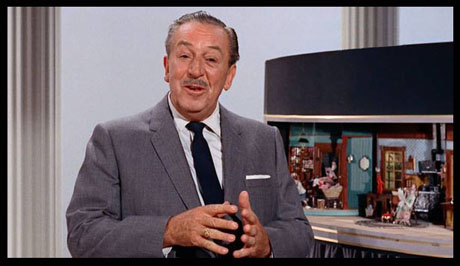
One of the things I have had to do very frequently in the past decade or more is defend Walt from unfounded accusations. Walt was not a saint, nor did he consider himself one. He definitely had his eccentricities and a fiery temper. However, he was not guilty of some of the misrepresentations that constantly get trotted out about him because “everyone knows they are true”.
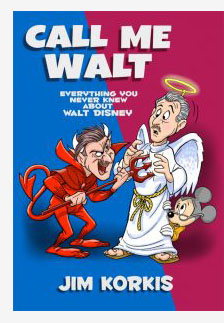 So I thought it was time to write a book that dealt with Walt as a person, a son, a brother, a husband, a father and a grandfather and not concentrate at all on his accomplishments. I depended on Walt’s own words, my nearly four decades of interviews with people who worked personally with Walt and out-of-the-ordinary documentation.
So I thought it was time to write a book that dealt with Walt as a person, a son, a brother, a husband, a father and a grandfather and not concentrate at all on his accomplishments. I depended on Walt’s own words, my nearly four decades of interviews with people who worked personally with Walt and out-of-the-ordinary documentation.
Call Me Walt: Everything You Never Knew About Walt Disney devotes chapters to each of his family members, his cars, his dogs, his hobbies, his taste in clothes and food, his political and religious beliefs and more. There are even chapters about his flaws like his fabled “bear suit” persona where he would lash out like a wounded bear at friends and family and his constant smoking.
I also devoted twelve chapters to trying to debunk some of the most common Walt myths with documentation. It is always challenging to prove a negative to the satisfaction of people who have already made up their minds. Of course, there are others who will still firmly proclaim that any documentation can be forged and where there is smoke, there must be fire. Finally, just the mere mention of these falsehoods often gives them unintended new life.
Walt was not cryogenically frozen but was cremated on December 17, 1966. Not only is this affirmed by Walt’s official death certificate signed with the name and license number of Forest Lawn embalmer Dean Fluss but also by Bob Nelson the president of the Cryonics Society of California (the only cryonics facility in the world at that time).
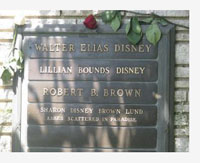
Walt Disney’s Memorial at
Forest Lawn Memorial Park
Glendale. Los Angeles. CA.
Nelson pointed out that the first cryonic suspension took place just a month after Disney’s death. Dr. James Bedford, a 73-year-old psychologist from Glendale, was suspended by Nelson and his team on January 12th, 1967. Bedford has yet to be revived.
Walt’s funeral was quietly held at the Little Church of the Flowers in Forest Lawn Cemetery, Glendale at 5:00pm on Friday, December 16, the day after his death. No funeral announcement was made until after it had taken place. Only immediate family members attended, no friends or business associates.
Forest Lawn officials refused to disclose any details of the funeral or disposition of the body, stating only that “Mr. Disney’s wishes were very specific and had been spelled out in great detail.” Walt’s wife, daughter Sharon and son-in-law Robert were all cremated as well.
Walt Disney was not anti-Semitic. Walt regularly donated (without any publicity just like his other charitable contributions) to a number of Jewish charities, like the Yeshiva College, the Jewish Home for the Aged and the Hebrew Orphan Asylum of the City of New York.
In 1955, the Beverly Hills chapter of B’nai B’rith (the oldest Jewish service organization in the world) declared Walt its “Man of the Year” after extensive investigation to determine if he had any anti-Semitic tendencies. The plaque read: “For exemplifying the best tenets of American citizenship and inter-group understanding and interpreting into action the ideals of B’nai B’rith.”
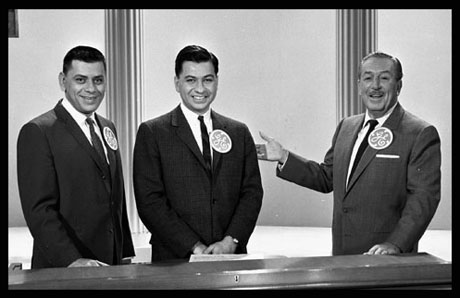
Robert Sherman was a Jewish-American composer who worked with his brother Richard to compose some of the most memorable Disney songs of all time including the music for the film Mary Poppins.
He shared the following story: “One time, [my brother] Richard and I overheard a discussion between Walt and one of his lawyers. This attorney was a real bad guy, didn’t like minorities. He said something about Richard and me, and he called us ‘these Jew boys writing these songs.’ Well, Walt defended us, and he fired the lawyer.”
Under Walt, many people of the Jewish faith held positions of authority at Walt Disney Productions including Marty Sklar, Kay Kamen, Richard Fleischer, David Swift, Harry Tyle, Sid Miller and dozens more.
“I can say that in extensive casting and personnel decisions, I never saw Walt being anti-Semitic. Too, I never even heard Walt make an anti-Semitic remark. Over the years, I’ve been amazed at how many different men Walt ‘really was’ as told by those who knew very little about him,” wrote producer Harry Tytle.
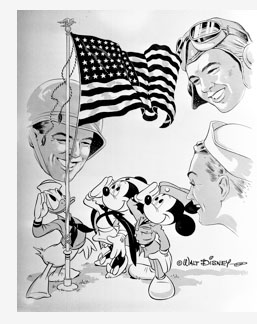 Walt Disney was not dishonorably discharged, court-martialed or had any other negative action taken against him by the U.S. military because Walt Disney never served in the U.S. Armed Forces. Walt’s volunteer duty with the Red Cross (a civilian organization) is often mistaken for actual military service.
Walt Disney was not dishonorably discharged, court-martialed or had any other negative action taken against him by the U.S. military because Walt Disney never served in the U.S. Armed Forces. Walt’s volunteer duty with the Red Cross (a civilian organization) is often mistaken for actual military service.
He never hung his supposed dishonorably discharged papers on the wall of his studio office upside down as a sign of disrespect and that they were clearly seen every week on his television show because those papers don’t exist. In addition, that office shown on television each week was a studio set.
Yet official tours of the Pentagon and basic training for new recruits repeated this myth for many years.
Walt Disney was not an active FBI informant. Walt Disney was not a Nazi sympathizer. Walt Disney was not dyslexic. Walt was not homosexual nor did he discriminate against those who were.
“Everytime we saw grandpa in the public or on television, he didn’t seem any different than when he was in his own living room or watching us play in the yard,” stated Walt Disney’s oldest grandson, Christopher Miller.
“Disney didn’t have a ‘dark side’. That’s literally nonsense,” stated director David Swift who worked directly with Walt on several popular Disney live action films. “He had a few quriks like you do and like I do. If there was a dark side, I never saw it.”
Walt Disney was not racist. Walt Disney was not a Freemason. Walt Disney was not born in Spain. He was not an alcoholic. Walt Disney was not scared of women nor did he hate them.
Hopefully, Call Me Walt can offer some logical defense and real facts for those people who are confronted by friends who claim to know the real “truth” about Walt Disney.
(This article originally appeared on out sister website, Cartoon Research, last week)
- Debunking Disney Urban Myths - November 24, 2017
- Remembering June Foray - July 27, 2017


 November 24th, 2017
November 24th, 2017  Jim Korkis
Jim Korkis  Posted in
Posted in  Tags:
Tags: 






